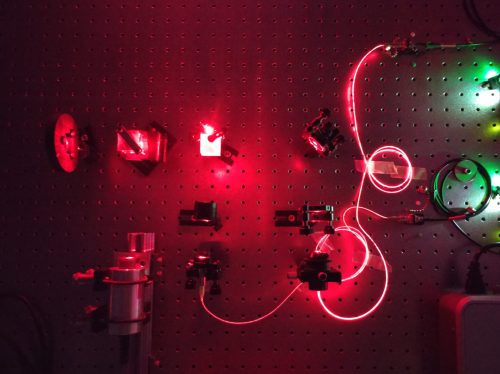At CIMaINa, we are advancing the frontier of free-space communication by leveraging one of the most powerful features of radiation: Orbital Angular Momentum (OAM). This property, formally described in the late 20th century, has opened new pathways in a wide range of disciplines—from quantum physics and microscopy to astronomy and information science.
Today, our research is focused on translating these foundational principles into real-world applications for high-capacity, long-range, and interference-resilient communication systems. OAM beams are characterized by a helical wavefront and a quantized topological charge, denoted by an integer ℓ, which defines the “twist” of the phase structure. Unlike polarization, which is inherently limited to two orthogonal states, OAM offers a theoretically unlimited set of orthogonal modes, each capable of carrying independent information.
This unique feature allows for dense multiplexing within a single frequency band, vastly increasing the information-carrying capacity of communication links. However, practical use of OAM in telecommunications has long been hindered by a fundamental challenge: beam divergence. As OAM beams propagate, especially over large distances, their transverse size grows significantly due to diffraction.
Conventional detection schemes require capturing the full beam profile to determine the topological charge, which becomes increasingly difficult or even impossible as the beam expands beyond the receiver’s aperture in the far field. At CIMaINa, we have developed and demonstrated a novel local interferometric detection method that overcomes this limitation.
By sampling only a small portion of the wavefront we are able to accurately decode OAM states without needing to capture the entire beam. This approach enables reliable and efficient detection, even when the singularity (the beam’s central vortex) is not within the receiver’s field of view. Furthermore, the detection baseline can be minimized depending on system sensitivity, making the method extremely versatile. In laboratory conditions, we have successfully realized a multiplexed asynchronous communication link, capable of transmitting multiple data streams simultaneously. A proof-of-concept system demonstrated parallel dense-coded transmission using overlapped OAM channels, with active compensation for pointing instabilities and turbulence. Our work focuses not only on expanding the theoretical capacity of OAM-based systems but on making that capacity practically accessible through compact, resilient, and scalable detection techniques. This is a foundational step toward enabling next-generation free-space communication infrastructures for satellite networks, aerospace systems, and terrestrial high-speed links, where bandwidth, weight, and energy efficiency are critical.
In contrast to traditional high-throughput OAM experiments that rely on bulk elements and large-scale receivers, our compact and adaptive local detection strategy offers a paradigm shift: one that makes dense OAM multiplexing feasible under real-world conditions. Through this line of research, CIMaINa is not only addressing long-standing bottlenecks in communication but actively shaping a new technological landscape, where radiation’s structure becomes a programmable resource for intelligent, high-efficiency, and scalable data transmission.

Referents:
Lorenzo Scalcinati, lorenzo.scalcinati@unimi.it
Luca Teruzzi, luca.teruzzi@unimi.it